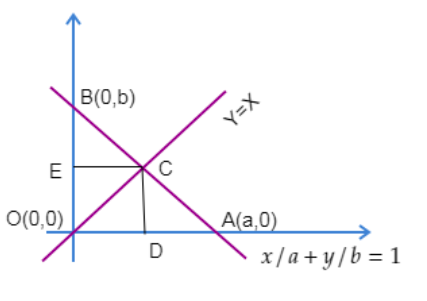
The line \[\dfrac{x}{a}+\dfrac{y}{b}=1\] meets the axis of x and y at A and B respectively and the line \[y=x\] at C so that area of the triangle AOC is twice the area of the triangle BOC, O being the origin, then one of the position of C is:
(a) \[\left( a,a \right)\]
(b) \[\left( \dfrac{2a}{3},\dfrac{2a}{3} \right)\]
(c) \[\left( \dfrac{b}{3},\dfrac{b}{3} \right)\]
(d) \[\left( \dfrac{2b}{3},\dfrac{2b}{3} \right)\]
Answer
511.8k+ views
Hint: Find the coordinates where the line \[\dfrac{x}{a}+\dfrac{y}{b}=1\] meets the coordinate axis. Draw a suitable diagram with these points and apply the area condition mentioned in the question. Area of a triangle can be found using \[\dfrac{1}{2}\times base\times height\].
Given that the line \[\dfrac{x}{a}+\dfrac{y}{b}=1\]meets the x axis at A and y axis at B.
Now, for point A:
Let us put \[y=0\], in the line \[\dfrac{x}{a}+\dfrac{y}{b}=1\]
\[\dfrac{x}{a}+\dfrac{0}{b}=1\]
\[x=a\]
So, Point A is \[\left( a,0 \right)\].
For point B:
Let us put \[x=0\]in the line \[\dfrac{x}{a}+\dfrac{y}{b}=1\]
\[\dfrac{0}{a}+\dfrac{y}{b}=1\]
\[y=b\]
So, Point B is \[\left( 0,b \right)\].
Therefore, we can plot the below diagram with the data we obtained.

Now let us assume point C as \[\left( m,m \right)\]since it lies on the line \[x=y\].
As mentioned in the question we have:
(Area of \[\vartriangle AOC\]) = 2(Area of \[\vartriangle BOC\])
\[\dfrac{1}{2}\times \left( OA \right)\left( CD \right)=2\times \dfrac{1}{2}\left( OB \right)\left( CE \right)\]
Since, area of triangle = \[\dfrac{1}{2}\times base\times height\].
We have:
\[OA=a\]
\[CD=m\]
\[OB=b\]
\[CE=m\]
Substituting the above values in \[\dfrac{1}{2}\left( a \right)\left( m \right)=\left( b \right)\left( m \right)\], we will have:
\[\therefore \dfrac{1}{2}\left( a \right)\left( m \right)=\left( b \right)\left( m \right)\]
\[a=2b\]
Now let us substitute \[a=2b\] in the line \[\dfrac{x}{a}+\dfrac{y}{b}=1\]
\[\dfrac{x}{2a}+\dfrac{y}{b}=1...........(1)\]
Substituting \[c\left( m,m \right)\] in the equation (1), we will have:
\[\dfrac{m}{2b}+\dfrac{m}{b}=1\]
\[3m=2b\]
\[m=\dfrac{2b}{3}\]
Therefore, the coordinates of C can be \[\left( \dfrac{2b}{3},\dfrac{2b}{3} \right)\].
Hence option D is the correct answer.
Note: We can also find the are of the triangle using the formula \[\dfrac{1}{2}\left| {{x}_{1}}\left( {{y}_{2}}-{{y}_{3}} \right)+{{x}_{2}}\left( {{y}_{3}}-{{y}_{1}} \right)+{{x}_{3}}\left( {{y}_{1}}-{{y}_{2}} \right) \right|\] when the three vertices of the triangle are known to us . But we adopt the formula of \[\dfrac{1}{2}\times base\times height\] to save time.
Given that the line \[\dfrac{x}{a}+\dfrac{y}{b}=1\]meets the x axis at A and y axis at B.
Now, for point A:
Let us put \[y=0\], in the line \[\dfrac{x}{a}+\dfrac{y}{b}=1\]
\[\dfrac{x}{a}+\dfrac{0}{b}=1\]
\[x=a\]
So, Point A is \[\left( a,0 \right)\].
For point B:
Let us put \[x=0\]in the line \[\dfrac{x}{a}+\dfrac{y}{b}=1\]
\[\dfrac{0}{a}+\dfrac{y}{b}=1\]
\[y=b\]
So, Point B is \[\left( 0,b \right)\].
Therefore, we can plot the below diagram with the data we obtained.

Now let us assume point C as \[\left( m,m \right)\]since it lies on the line \[x=y\].
As mentioned in the question we have:
(Area of \[\vartriangle AOC\]) = 2(Area of \[\vartriangle BOC\])
\[\dfrac{1}{2}\times \left( OA \right)\left( CD \right)=2\times \dfrac{1}{2}\left( OB \right)\left( CE \right)\]
Since, area of triangle = \[\dfrac{1}{2}\times base\times height\].
We have:
\[OA=a\]
\[CD=m\]
\[OB=b\]
\[CE=m\]
Substituting the above values in \[\dfrac{1}{2}\left( a \right)\left( m \right)=\left( b \right)\left( m \right)\], we will have:
\[\therefore \dfrac{1}{2}\left( a \right)\left( m \right)=\left( b \right)\left( m \right)\]
\[a=2b\]
Now let us substitute \[a=2b\] in the line \[\dfrac{x}{a}+\dfrac{y}{b}=1\]
\[\dfrac{x}{2a}+\dfrac{y}{b}=1...........(1)\]
Substituting \[c\left( m,m \right)\] in the equation (1), we will have:
\[\dfrac{m}{2b}+\dfrac{m}{b}=1\]
\[3m=2b\]
\[m=\dfrac{2b}{3}\]
Therefore, the coordinates of C can be \[\left( \dfrac{2b}{3},\dfrac{2b}{3} \right)\].
Hence option D is the correct answer.
Note: We can also find the are of the triangle using the formula \[\dfrac{1}{2}\left| {{x}_{1}}\left( {{y}_{2}}-{{y}_{3}} \right)+{{x}_{2}}\left( {{y}_{3}}-{{y}_{1}} \right)+{{x}_{3}}\left( {{y}_{1}}-{{y}_{2}} \right) \right|\] when the three vertices of the triangle are known to us . But we adopt the formula of \[\dfrac{1}{2}\times base\times height\] to save time.
Recently Updated Pages
Glucose when reduced with HI and red Phosphorus gives class 11 chemistry CBSE

The highest possible oxidation states of Uranium and class 11 chemistry CBSE

Find the value of x if the mode of the following data class 11 maths CBSE

Which of the following can be used in the Friedel Crafts class 11 chemistry CBSE

A sphere of mass 40 kg is attracted by a second sphere class 11 physics CBSE

Statement I Reactivity of aluminium decreases when class 11 chemistry CBSE

Trending doubts
10 examples of friction in our daily life

Difference Between Prokaryotic Cells and Eukaryotic Cells

One Metric ton is equal to kg A 10000 B 1000 C 100 class 11 physics CBSE

State and prove Bernoullis theorem class 11 physics CBSE

What organs are located on the left side of your body class 11 biology CBSE

Define least count of vernier callipers How do you class 11 physics CBSE




